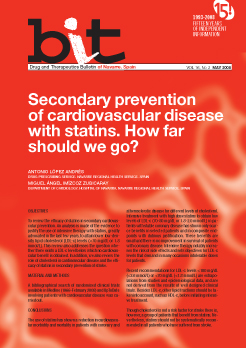Secondary prevention of cardiovascular disease with statins. How far should we go?
The use of statins has shown a reduction in cardiovascular morbidity and mortality in patients with coronary and atherosclerotic disease for different levels of cholesterol. Intensive treatment with high dose statins to obtain low levels of LDL-c (70-80 mg/dL or 1.8-2.0 mmol/L) in patients with stable coronary disease has shown only scarce benefits in selected patients and in composite endpoints with dubious justification. These benefits are small and there is no improvement in survival of patients with coronary disease. Intensive therapy notably increases the risk of side effects and sets objectives for LDL-c levels that demand in many occasions intolerable doses for patients.
Recent recommendations for LDL-c levels <100 mg/dL (<2.6 mmol/L) or <70 mg/dL (<1.8 mmol/L) are extrapolations from studies and epidemiological data, and are not derived from the results of well designed clinical trials. Besides LDL-c, other lipid fractions should be taken into account, such as HDL-c, before initiating intensive treatment.
Though cholesterol is not a risk factor for stroke there is, however, a group of patients that benefit from statins. Nevertheless, statins should not be systematically recommended in all patients who have suffered from stroke.
Authors:
- Antonio López. Drug Information Unit. Navarre Health Regional Service. Spain.
- Miguel Ángel Imízcoz. Department of Cardiology. Hospital de Navarra. Spain


